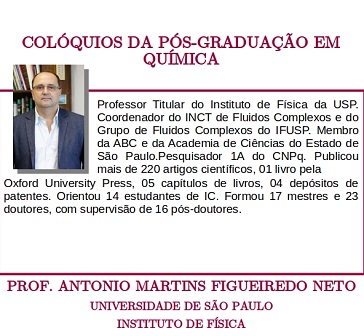Todas as Notícias
- UFPE/
- Institucional/
- Superintendências/
- Superintendência de Comunicação (Supercom)/
- Agência de Notícias (Ascom)/
- Notícias/
- Pós-Graduação em Química promove colóquio sobre as propriedades não lineares das lipoproteínas humanas de baixa densidade
 Notícias Notícias
Notícias Notícias
Pós-Graduação em Química promove colóquio sobre as propriedades não lineares das lipoproteínas humanas de baixa densidade
O encontro será realizado no dia 15, das 10h às 11h30, no Auditório Benício de Barros
 O Programa de Pós-Graduação em Química (PPGQuímica) da UFPE promoverá um colóquio intitulado “Nonlinear Properties Of Human Low-Density Lipoproteins”. O encontro será realizado nesta sexta-feira (15), das 10h às 11h30, no Auditório Benício de Barros, situado no Departamento de Química Fundamental (dQF) da UFPE. O tema será abordado pelo professor Antonio Martins Figueiredo Neto.
O Programa de Pós-Graduação em Química (PPGQuímica) da UFPE promoverá um colóquio intitulado “Nonlinear Properties Of Human Low-Density Lipoproteins”. O encontro será realizado nesta sexta-feira (15), das 10h às 11h30, no Auditório Benício de Barros, situado no Departamento de Química Fundamental (dQF) da UFPE. O tema será abordado pelo professor Antonio Martins Figueiredo Neto.
O convidado Antonio Figueiredo é professor do Instituto de Física da Universidade de São Paulo (USP). Além disso, é coordenador do INCT de Fluidos Complexos e do Grupo de Fluidos Complexos do IFUSP. Também é membro da ABC e da Academia de Ciências do Estado de São Paulo.
Resumo
Mixtures of amphiphilic molecules and a solvent may present lyotropic liquid crystalline (LLC) mesophases. Due to hydrophobic/hydrophilic interactions, super-structures, i.e., micelles are formed, and these are the LLC basic units. The human Low-Density Lipoprotein (LDL) is the main carrier of cholesterol from the liver to the different loci of the body. The cholesterol molecule (CH) is not soluble in blood. LDL is a spherical nanoparticle (diameter of about 20 nm) formed, mainly, by phospholipids, that cages the CH esters and triglycerides. The shape and structure of the LDL resembles that of a micelle in LLC. Modified (e.g., by free-radicals) LDL are atherogenic. Since the nonlinear optical properties (NLO) of LLC depends on the basic unit structure and composition, it is expected that these properties depend on the state of modification of the LDL. The Z-Scan (ZS) experimental technique was used to evaluate the modification state of LDL in in vitro and in vivo essays. In the in vitro essays, the LDL was oxidized with CuSO4 and, in the in vivo essays, the LDL from donors with different pathologies (e.g., diabetes Mellitus, periodontitis, COVID-19) were studied. We showed that the amplitude of the thermal lens (TL) formed in the ZS experiment depends on the modification state of the LDL: nonmodified LDL particles show a higher amplitude of the TL, when compared with that from the modified particles. With this technique we showed that the COVID-19 leaves a sequel in the LDL of the patients, even after 1 year of the cure.





